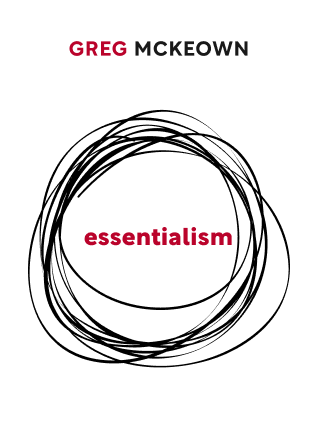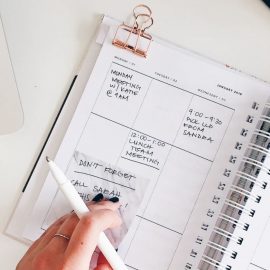

This article is an excerpt from the Shortform book guide to "Essentialism" by Greg McKeown. Shortform has the world's best summaries and analyses of books you should be reading.
Like this article? Sign up for a free trial here .
How do you feel at the end of your typical day? Do you feel proud of what you’ve achieved or disappointed, wishing you could do more? Do you wish you could live a productive life day in and day out?
Most people’s lives are composed of good days and bad days when they feel both of those things. Few people live a productive life day in and day out because they focus on how they can do more in less time. But the real boost in productivity comes from things that have nothing to do with that.
Here is how to lead a productive life day in and day out.
How to Live a Productive Life
When most people try to be more productive, they focus on how they can complete more tasks in less time. But if you want to live a productive life day in and day out, you need to think about the bigger picture. Here are some tips on how to lead a productive life day in and day out:
1) Remove Obstacles
In your work and personal life, you face obstacles that keep you from achieving what matters to you or that slow the process. But by systematically identifying and removing these constraints, you will significantly improve your baseline productivity and increase your work output. You do it, not by trying to fix everything at once, but by starting with the most critical obstacle, where improvement will have the biggest impact.
Here are some steps to identifying and removing obstacles, using the example of preparing a 15-page report for a client:
- Be clear about your purpose: You can’t determine what obstacles to remove unless you’re clear on what you’re trying to achieve — in this case, your objective is producing and delivering your report by 2 p.m. Friday. With that level of specificity, it will be easier to identify obstacles.
- Identify the weakest point or “slowest hiker”: Make a list of what obstacles are keeping you, or might keep you, from achieving your purpose. They might include not having all the information you need, your desire for perfection, or your energy level. Determine the obstacle that, if removed, would make the biggest difference or eliminate most of the other obstacles. There may be multiple obstacles, but removing them won’t facilitate the project if the primary obstacle isn’t addressed — so you have to focus on the right one.
- Remove the primary obstacle: Maybe the key obstacle is your desire to make the report perfect and this is slowing things down. To remove the obstacle, make your priority getting the report done on time, rather than being perfect. When you remove the key obstacle, most other aspects of the job become easier. The weak point could be another person — a finance director who won’t approve your budget, for instance. To remove a human obstacle, go and see the person and ask how you can help (remove his obstacles).
2) Create Momentum With Small Wins
People who live a productive life day in and day out don’t try to do too much in a short period of time as that leads to burnout, which undermines productivity in the long run. Instead, they chalk up big goals into small milestones and celebrate when they achieve them.
As each small win propels you toward the next win, you build momentum until you achieve a significant breakthrough. The progress will seem effortless. Here are some techniques for creating an effortless system:
1) Determine your minimal viable step: In conceiving new products, entrepreneurs seek the simplest product a customer will find valuable — the minimal viable product. The idea is to avoid wasting resources on nonessential features. You can apply the principle by determining the smallest amount of progress that will be useful in accomplishing your essential task. The author used this method to explore the viability of writing this book. His minimal viable step was to share an idea on Twitter, and if it resonated, he’d write a blog further developing it. From there, he progressed to writing the book.
2) Apply minimal viable preparation: To accomplish your essential task, start early and start small. Start as soon as possible with the minimal time investment necessary to make progress.
For example, you could invest a small amount of time in a project two weeks before the deadline and it could help you avoid stress later. Think of a task or deadline and consider the minimum you could do now.
3) Visually depict progress: Whether it’s fundraising thermometer charts or star charts for chores at home, kids and adults like to see their progress toward a goal. As a motivator, try keeping visual track of your progress on a project.
3) Design a Routine
Following a routine is key to living a productive life day in and day out. With a routine, you can execute automatically without expending energy figuring out what’s next. It also helps you counter the pull of nonessential distractions.
Routines make challenging things easier, although the reasons aren’t entirely clear. It may be that as you repeat something, you strengthen neural connections, making it easier for the brain to activate them. For example, it takes several repetitions and applications of a new word before you learn it. Once you’ve activated the same synapses or connections repeatedly you know the word without consciously thinking about it. Similarly, you can eventually make a familiar meal without looking at the recipe or drive the same route routinely without thinking about it.
In the same way, your ability to execute essential tasks gets better with practice, until the tasks become routine. And when you follow a routine, mental space is freed up. You can perform one essential task flawlessly while thinking about another. In The Power of Habit, Charles Duhigg notes the brain can almost shut down when performing a routine, allowing you to focus on something else.
The wrong routines can be boring and stifle creativity. However, the right ones boost creativity by saving mental energy that you can redirect to another essential activity.

———End of Preview———
Like what you just read? Read the rest of the world's best book summary and analysis of Greg McKeown's "Essentialism" at Shortform .
Here's what you'll find in our full Essentialism summary :
- How to do less but to do it better
- Why you need to be disciplined in your pursuit of less
- How you can learn to say no






